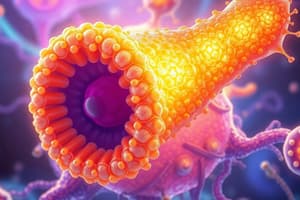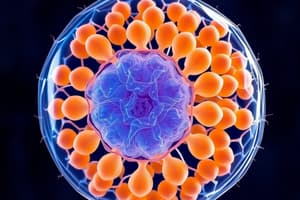Podcast
Questions and Answers
What is the main role of mitochondria in eukaryotic cells?
What is the main role of mitochondria in eukaryotic cells?
- Photosynthesis in plant cells
- Storage of genetic information
- Generating ATP through cellular respiration (correct)
- Digestion of cellular materials
Which of the following does NOT describe the structure of mitochondria?
Which of the following does NOT describe the structure of mitochondria?
- Lacks internal compartments (correct)
- Contains circular DNA
- Surrounded by a double membrane
- Has highly folded inner membrane called cristae
What is the function of peroxisomes in eukaryotic cells?
What is the function of peroxisomes in eukaryotic cells?
- Break down fats and amino acids (correct)
- Synthesize ATP from glucose
- Store calcium ions
- Rebuild damaged organelles
Which statement correctly describes the function of endosomes in eukaryotic cells?
Which statement correctly describes the function of endosomes in eukaryotic cells?
What is the primary function of ribosomes in a cell?
What is the primary function of ribosomes in a cell?
What is produced as a by-product of metabolic reactions in peroxisomes?
What is produced as a by-product of metabolic reactions in peroxisomes?
What is the primary function of rough endoplasmic reticulum (rER)?
What is the primary function of rough endoplasmic reticulum (rER)?
What do secretory vesicles transport to the cell membrane?
What do secretory vesicles transport to the cell membrane?
Which subunits compose Eukaryotic ribosomes?
Which subunits compose Eukaryotic ribosomes?
Which type of digestion is primarily carried out by lysosomes?
Which type of digestion is primarily carried out by lysosomes?
Where do free ribosomes primarily synthesize proteins for?
Where do free ribosomes primarily synthesize proteins for?
Which of the following is NOT a function of smooth endoplasmic reticulum (sER)?
Which of the following is NOT a function of smooth endoplasmic reticulum (sER)?
What pH level do lysosomal enzymes work best at?
What pH level do lysosomal enzymes work best at?
Which of the following describes the role of cytosol?
Which of the following describes the role of cytosol?
How do transport vesicles utilize the Golgi apparatus?
How do transport vesicles utilize the Golgi apparatus?
What is the main functional difference between free ribosomes and bound ribosomes?
What is the main functional difference between free ribosomes and bound ribosomes?
What role do vacuoles play in plant cells?
What role do vacuoles play in plant cells?
What components make up the cytoskeleton?
What components make up the cytoskeleton?
Which component is responsible for the detoxification of poisons in liver cells?
Which component is responsible for the detoxification of poisons in liver cells?
What is the role of secretory vesicles in a cell?
What is the role of secretory vesicles in a cell?
What is a key difference between vacuoles and vesicles?
What is a key difference between vacuoles and vesicles?
What primary function does the Golgi apparatus serve?
What primary function does the Golgi apparatus serve?
What is one of the functionalities of the smooth endoplasmic reticulum (sER)?
What is one of the functionalities of the smooth endoplasmic reticulum (sER)?
Which organelles primarily use the cytoplasm for chemical activities in eukaryotic cells?
Which organelles primarily use the cytoplasm for chemical activities in eukaryotic cells?
Flashcards are hidden until you start studying
Study Notes
Endoplasmic Reticulum (ER)
- A series of interconnected channels and sacs called cisternae.
- Two forms: Rough ER (rER) and Smooth ER (sER)
- Rough ER (rER): Covered with ribosomes and synthesizes new membrane for the cell.
- Smooth ER (sER): No ribosomes. Involved in:
- Synthesis of membrane components like fatty acids and phospholipids
- Synthesis of steroid hormones
- Metabolism of carbohydrates
- Detoxification of poisons, particularly in liver cells
Golgi Apparatus
- Composed of flattened, disk-like vesicles stacked together, located near the rER.
- Plays a crucial role in modifying and packaging proteins made on ribosomes attached to the rER (bound ribosomes).
- Transport vesicles fuse with one side of the Golgi and leave from the opposite side.
- Sorts and modifies lipids and proteins as they move from the cis to the trans side.
- Functions: Modify, sort, package, and manufacture/synthesize.
- Often referred to as the "mail center" of the cell.
Vacuoles
- Space or cavity in the cytoplasm enclosed by a single membrane.
- Larger than vesicles, can be derived from the ER and Golgi complex.
- Specific functions vary depending on the cell type.
- In plants:
- Temporary storage organelles for proteins, nutrients, water, sugars, etc.
- Store wastes and poisons to prevent toxicity to the cytoplasm (used for defense against predation).
- Internal strength through turgor: Central vacuole takes up water, enabling plant cells to increase in size and provide rigidity to leaves and stems.
- In animals: Involved in exocytosis and endocytosis (secretory, excretory & storage functions).
Vesicles
- Small membrane-enclosed transport units that transfer molecules between different cellular compartments.
- Can fuse with other cell membranes.
- Often referred to as "shuttle vehicles".
Lysosomes
- Membrane-enclosed spheres bound by a single membrane.
- Contain about 40 different enzymes that work best in an acidic pH (4.5).
- Function in the cell by:
- Digesting other cells through phagocytosis.
- Recycling cellular materials that have exceeded their lifespan and recycling cellular organic material through autophagy.
Endosomes
- Membrane-bound compartment inside eukaryotic cells.
- Provide an environment for material taken into the cell by receptor-mediated endocytosis to be sorted before reaching the lysosome.
Secretory Vesicles
- Transport molecules to the cell membrane for secretion.
Mitochondria
- Sites of cellular respiration, a process that generates ATP (the energy molecule of the cell).
- Found in all eukaryotic cells.
- Approximately 1–10 µm long.
- Structure:
- Large organelles containing circular DNA.
- Surrounded by a double membrane:
- Inner membrane: Highly folded, folds are called cristae.
- Outer membrane: Encloses the organelle.
- These membranes divide the mitochondrion into two compartments:
- Central matrix: Contains DNA in the form of a circular molecule.
- Intermembrane space: Space between the inner and outer membranes.
- Mitochondrial DNA: Encodes many of the components for mitochondrial function, while nuclear DNA encodes for the remaining components.
Peroxisomes
- Found in both plant and animal cells.
- Break down fats and amino acids into smaller molecules that can be used for energy production by mitochondria.
- Cytoplasmic vesicles where metabolic reactions occur that transfer hydrogen from various substrates to oxygen, producing hydrogen peroxide (H2O2) as a by-product.
- H2O2 is highly reactive and toxic and is rapidly broken down by the enzyme catalase.
Ribosomes
- Translate the DNA genetic code into proteins.
- Composed of RNA and protein.
- Two subunits:
- Eukaryotic ribosomes: 60S and 40S subunits that come together during protein synthesis to form an 80S ribosome.
- Prokaryotic ribosomes: 50S and 30S subunit that come together during protein synthesis to form a 70S ribosome.
- Occur in the cell either free in the cytoplasm or bound to the ER.
- Bound ribosomes produce proteins destined for:
- Plasma membrane
- Nuclear membrane
- Lysosomes
- Golgi
- Vacuoles
- Secretory vesicles.
- Free ribosomes synthesize proteins destined to be enzymes used in:
- Cytoplasm (cytoplasmic enzymes)
- Mitochondria
- Chloroplasts.
Cytoplasm
- Region in eukaryotic cells between the cytoplasmic membrane and nuclear membrane.
- Contains all the cell’s internal substructures (organelles) except the nucleus.
- Liquid part: Cytosol.
- Site of almost all the chemical activity occurring in a eukaryotic cell.
Nucleoplasm
- Similar to the cytoplasm of a cell.
- Found inside the nucleus.
Cytosol
- Aqueous component of the cytoplasm of a cell.
- Within which various organelles and particles are suspended.
Cytoskeleton
- Consists of:
- Microtubules
- Intermediate fibers
- Microfilaments
- Functions:
- Maintaining cell shape
- Anchoring organelles
- Facilitating cell movement.
Studying That Suits You
Use AI to generate personalized quizzes and flashcards to suit your learning preferences.




